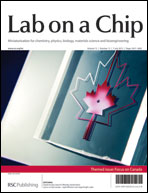A 3D microfluidic platform incorporating methacrylated gelatin hydrogels to study physiological cardiovascular cell–cell interactions
Abstract
The cardiovascular system is particularly well-suited to modelling with microfluidic technologies, and much progress has been made to create microfluidic devices that mimic the microvasculature. In contrast, microfluidic platforms that model larger blood vessels and heart valves are lacking, despite the clear potential benefits of improved physiological relevance and enhanced throughput over traditional cell culture technologies. To address this need, we developed a bilayer membrane microfluidic device to model the vascular/valvular three-dimensional environment. Key features of the platform include physiologically-relevant spatial arrangement of multiple cell types, fluid flow over an endothelial monolayer, a porous membrane that permits heterotypic cell interactions while maintaining cell compartmentalization, and a photopolymerizable gelatin methacrylate (gel-MA) hydrogel as a physiologically-relevant subendothelial 3D

- This article is part of the themed collection: Focus on Canada

 Please wait while we load your content...
Please wait while we load your content...